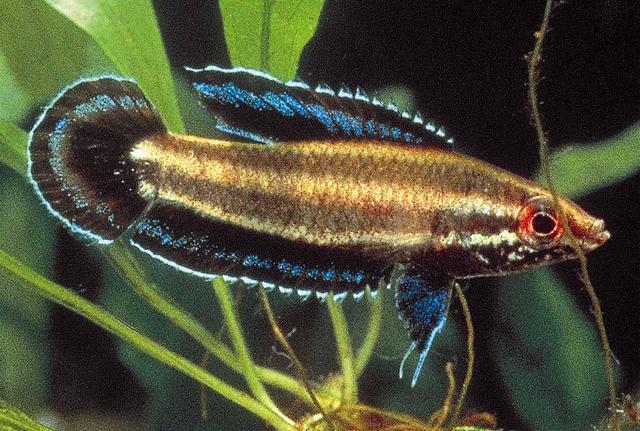
Kottelat & Ng 1998
First description: Parosphromenus bintan, a new osphronemid fish from Bintan and Bangka islands, Indonesia, with redescription of P. deissneri. Ichthyological Exploration of Freshwaters, 8: 263-272.
Characteristics: Overall length max. 3.5 cm. Dorsal structure: XI-XIII, 5-7, total 17-20, Anal: XI-XIII, 8-10, total 19-22. ♂ in breeding colours, with thin white-lined unpaired fins, in which both sides show a blue band, framed by broad dark zones, central zone of the caudal, a dirty red-black. Pelvic fins blue with relatively short white-blue filaments. ♀ differentiation is hardly possible from other species with a round tail based on color characteristics – consideration of fin formula is required. Courtship coloring of ♀: pale-beige color. Because many similar, but sometimes differently-colored forms have been discovered since the first description and further round-tailed forms have been described in 2005 by the same authors, the species delimitation has once again become questionable (“bintan complex”) if not, according to Kottelat & Ng, the isolated island-like occurrence is regarded as a sufficient evidence for their own species status. Especially in this bintan complex, genetic studies are needed.
Similar species: Kottelat and Ng redefined the species P. deissneri in the same publication, so P. bintan can not be confused anymore due to the significant structural differences and color differences of both types. In males, the risk of confusion with other licorice gouramis is low, because of the color differences in the phenotypic differentiation of described round-tail-Parosphromenus. But for many, still undescribed, forms from other regions (eg, “spec.” blue line “, spec. Sentang, both Sumatra) the risk is quite high. In females it is generally very high. It can be assumed that there is already confusion, and some accidental hybridization might have already occurred. P.deissneri was characterised as the point-tailed sp based on their finding the sp. in the same location as the original description but of course the original (Bleeker) description was based on a female !!
Occurrence / Distribution: according to the first description, they are endemic to the Malaysian islands of Bintan and Bangka, but in fact, mainly due to the recent discoveries in Sumatra and Borneo, the distribution is unclear again.
Threat: High. If the species is endemic on the island, it is very high. If they are (partly) identical with other forms in other places, it is less so but still high in general. Each of the individual forms is highly endangered.
Discovery / First import: Difficult to determine. Has probably been imported unnoticed long before the first description.
Trade: In the trade, it is almost impossible to disentangle the name and identification confusion. The wild-caught fish, sometimes offered under the false name “P. deissneri” are imported only rarely from the islands of Bangka and Bintan. The point of view that it is really P. bintan, cannot be correct in many cases. This goes mainly back to the still widespread simplification “the fish formerly known as deissneri is now called bintan“. There may also be other confusions with other round-finned forms of licorice gouramis from Malaysia or Indonesia. The discovery of new forms, especially from Sumatra, increases the name confusion in the trade even more.
Care / Breeding: Standard conditions for licorice gourami-keeping and breeding. The ‘Team Borneo’ has measured pH values of 4.8, GH levels of 0, KH values of 1 and a temperature of 25.2 degrees Celsius, with slightly brown water for locations in Pulau Bintan and Pulau Bangka.
Behaviour / Particularities: No special features. Head-down-courtship. Moderately distinct foam nest, sometimes only rudimentary. Accompanying fish such as Betta species (eg B. burdigala, B.chlorpharynx or B. schalleri) occur in the native habitat, in which B. Burdigala would occur on the forest floor, – and P. Bintan in the streams around the forest. This would also mean that it would not be appropriate to keep these in the same aquarium.
Literatur:
Weblinks:
(PF/DA)

